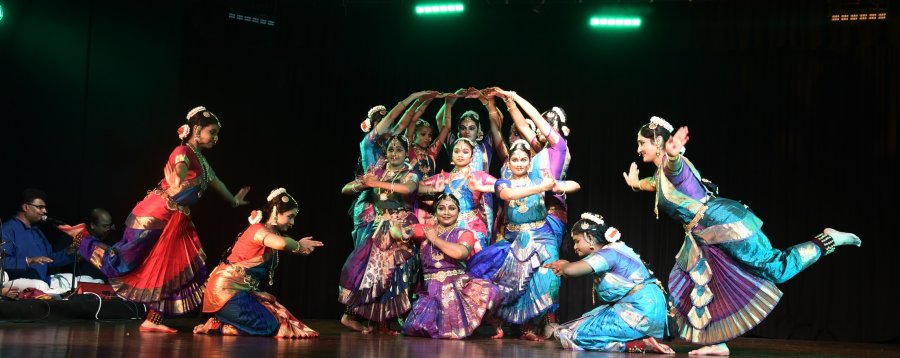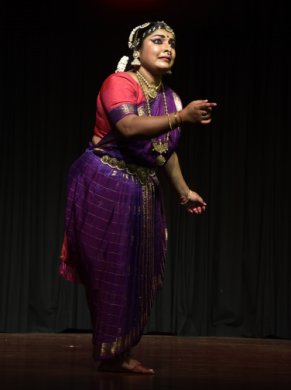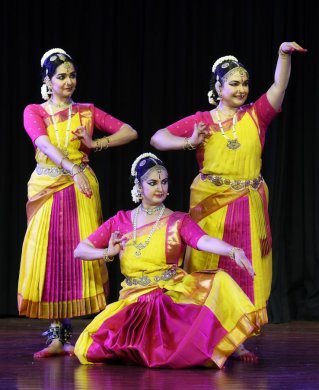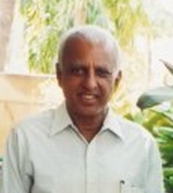
|   |

|   |
'Daasaru Kanda Krishna' and 'Soundarya Tarangini' - Satish Suri e-mail: satishism@yahoo.co.in October 27, 2023 DAASARU KANDA KRISHNA Photos: Shandilya Srivatsa The presentation 'Daasaru Kanda Krishna' by Raksha Karthik and her disciples of the Natanam Institute of Dance on 30th September at Yuvaka Sangha, Jayanagar, Bangalore, was a captivating exploration of various aspects of Lord Krishna's life. This thematic presentation inspired by the splendour of the compositions of Purandaradasa, comprehensively delved into Krishna's life from his birth to his profound teaching in the form of the Gita to Arjuna.  The concept and choreography by Raksha Karthik, along with the carefully selected compositions of Purandaradasa, formed the backbone of this performance. The selection of specific compositions and the way they were choreographed allowed for a detailed and immersive exploration of various aspects of Lord Krishna's life and stories. The use of sancharis in this performance helped in conveying the rich narrative and thematic elements of Krishna's life. As a prelude to the main performance, the junior students of Natanam Institute of Dance presented "Narayana Hari Govinda". The artistes Aditi, Kreiti, Sarayu, Rhea, Sadhana, Vrinda, Natasha, Shruthi and Charulekha explored the Dasavataras of Vishnu attesting to their skills of training under their teacher. This was followed by a Devarnama "Mella mellane" presented by Sumeru, Diya, Khushi, Vihaana, Nidhi, Saanvi, Surabhi, Vishrutha and Devangshee, depicting the pranks of Krishna. The main program commenced with the traditional Alarippu. Raksha Karthik and her disciples showcased their talent and skill through their combinations and lively movement profiles. The dancer's synergy and coordinated movements played a significant role in keeping the audience engaged throughout the performance. The compositions of Purandaradasa like Devaki nandana, Jagadhodharana, Aado hodhalli, Krishna nee begane baro, Dayavirali damodara, Aadidano ranga. Pillangovia cheluva, Deva banda namma Swami bandhano, Yamanelli, Hariye gathi, Bagilano teradu, Entha punyava gopi and finally Ee pariya sobhaghave provided for their expression through themes like birth of Krishna, little Krishna showing the universe in his mouth, Putana and Shakatasura episodes, the dance at Brindavan, the Kalinga episode, Gopi Vastrapaharana, lifting of the Govardhangiri, Kubja episode, kidnapping of Rukmini, Sudhama episode, Draupadi Vastraharana and final exposition of the Bhagavad Gita to Arjuna by Krishna. Raksha Karthik showcased her skill in the solo performance of "Krishna nee begane baro."  Raksha Karthik The presentation was enhanced by the aesthetics of the costumes and vibrant colours that the performers wore. The flowing fabrics created a sense of movement and dynamism, as well as contrasted with the background. The colour scheme was well-chosen and harmonized with the theme of the presentation. The fact that the performance lasted over three hours and still managed to sustain the audience's interest speaks of the artiste's skill and the immersive quality of the presentation. The dancers demonstrated their histrionic abilities and added a creative and expressive dimension that enhanced the overall experience for the audience, making the performance not just a recital of traditional stories but a truly engaging and emotionally charged portrayal of Krishna's life. The program was a dedication to her Late Guru Bhanumathi. Balasubramanya Sharma's vocal rendering formed the core of the musical aspect of the performance. Supporting him were B.V. Devaraju (nattuvangam), Srihari Rangaswamy (mridangam), Jayaram Kikkeri (flute), Prasanna Kumar (rhythm pads) and Gopal Venkatramana (veena) who created a harmonious backdrop for the dance performance. SOUNDARYA TARANGINI Photos: Madhusudhan The three disciples of Late Guru Bhanumathi - Sneha Srinivas, Divya Prasad and Rohini Manjunath - showcased their talent and devotion in 'Soundarya Tarangini', a tribute to the supreme mother of creation, on 7th October at Yuvaka Sangha, Jayanagar, Bangalore. They began with Pushpanjali in Hamsadhwani raga, a respectful salutation with flowers. This was followed by Saraswathi Kautvam, a composition of Maharaja Jayachamarajendra Wodeyar set to music by Mahesh Swamy, which praises the goddess of knowledge, power and wisdom, who is revered by all. Sneha Srinivas impressed with her graceful expressions and gestures and her ability to convey the emotions and nuances of the composition.  The varnam "Simhavahini Sri Rajarajeshwari" is a musical composition by Madurai R Muralidharan in raga Ranjini and adi talam. It praises the supreme empress who rides on a lion and captivates the mind of Lord Nataraja. The choreography by Sheela Chandrasekhar showcased the different aspects of the empress through the elegant and expressive dance of the trio. The rhythmic patterns well synchronized with the music and the lyrics, created a harmonious and aesthetic performance. The charanam "Omkara naada maya roopini Nataraja manohari" depicts the empress as the embodiment of the primordial sound and the enchantress of the Lord of Dance, with majestic and fluid movements that match the choreography, lyrics and music. Rohini Manjunath presented a captivating exposition of "Meenakshi Thaaye," the divine mother who embodies compassion and valour and protects her creation. The piece began with a shloka of Adi Sankaracharya, "Pranathosmi Meenakshi," expressing devotion to the goddess. Choreographed by Guru Bhanumathi, the performance was a blend of graceful movements and vivid imagery that brought out the essence of the theme. "Paahi Jagat Janani," a composition by Swati Tirunal in Hamsanandi raga, was eloquently showcased by Divya Prasad. This composition pays homage to Maha Tripura Sundari, the mother of the mighty Brahman, representing the creative and nurturing aspect of the divine, responsible for all the universes. Divya Prasad effectively synchronized her movements and facial expressions to portray the character and emotions of the Mother of Creation. The choreography, guided by Sheela Chandrasekhar, played a pivotal role in shaping the performance. "Tarale ranne" is a musical piece composed by Purandaradasa, known for its witty and humorous style, as it depicts a conversation between Parvathi and Lakshmi, the consorts of Lord Shiva and Lord Vishnu respectively. In this piece, the two goddesses tease each other about their husbands' quirks and flaws, while also praising their virtues. Lakshmi mocks Lord Shiva for his unconventional appearance, such as his ash-smeared body, his dwelling in the cremation ground, his dreadlocks, and his accessories like a deerskin and a necklace of skulls. Parvathi retorts by pointing out Lord Vishnu's strange habit of reclining on a serpent in the middle of the ocean. Purandaradasa, cleverly resolves this friendly dispute by revealing the sublime spiritual truth that both Lord Shiva (Hara) and Lord Vishnu (Hari) are essentially the same, representing the oneness of divinity. Sneha Srinivas and Diya Prasad demonstrated their talent by delivering the nuances of this piece with finesse. They managed to convey the satire and the deeper philosophical meaning while keeping the humour intact, which shows their artistry and comprehension of the material. The program concluded with a Mangalam. The music ensemble with Debur Srivatsa (vocals), Sheela Chandrasekhar (nattuvangam), Narayanswamy (mridangam), Jayaram Kikkeri (flute) and Prashanth (veena) provided the musical landscape that added value to the presentation. Their individual and collective contributions created the right atmosphere, rhythm, and emotions for the performance, making it a memorable and aesthetically pleasing experience.  Bangalore based Satish Suri is an avid dance rasika besides being a life member of the Music and Arts Society. |